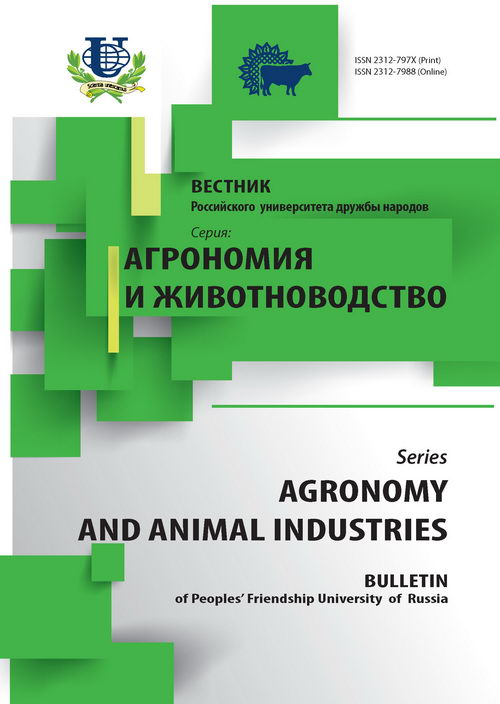Биотизация растений in vitro
- Авторы: Яблонская М.И.1, Гинс М.С.1, Молчанова М.А.1
-
Учреждения:
- Российский университет дружбы народов
- Выпуск: № 1 (2016)
- Страницы: 15-20
- Раздел: Статьи
- URL: https://agrojournal.rudn.ru/agronomy/article/view/1455
- DOI: https://doi.org/10.22363/2312-797X-2016-1-15-20
- ID: 1455
Цитировать
Полный текст
Аннотация
Использование симбиотических микроорганизмов при клональном микроразмножении повышает устойчивость растений к негативным биотическим и абиотическим факторам. Биотизация растений подразумевает собой использование в качестве инокулюма пропагул симбиотических бактерий (бактеризация) и грибов (микоризация) и является распространенным приемом при производстве клональных микрорастений в европейских странах. При размножении in vitro этап акклиматизации считается критическим и происходит массовая гибель растений, в связи с чем использование приема биотизации поможет повысить выживаемость растений и является перспективным методом при клональном микроразмножении.
Ключевые слова
Об авторах
Маргарита Игоревна Яблонская
Российский университет дружбы народов
Автор, ответственный за переписку.
Email: margarita-rudn@list.ru
Агробиотехнологический департамент
Мурат Сабирович Гинс
Российский университет дружбы народов
Email: anirr@bk.ru
Агробиотехнологический департамент
Мария Андреевна Молчанова
Российский университет дружбы народов
Email: masha013@mail.ru
Агробиотехнологический департамент
Список литературы
- Yildiz A., Cagdas A., Aslihan A., Yesim Y., Sedat S., Ibrahim O. The effect of mycorrhiza in nutrient uptake and biomass of cherry rootstocks during acclimatization // Romanian Biotechnological Letters. 2010. Vol. 15. № 3. P. 5246-5252.
- Schüßler A., Schwarzott D. Walker C. A new fungal phylum, the Glomeromycota: phylogeny and evolution // Mycol. Res. 2001. Vol. 105. P. 1413-1297.
- Jakobsen I. Transport of phosphorus and carbon in arbuscular mycorrhiza // Mycorrhiza: structure, function, molecular biology, and biotechnology. 2nd ed. Berlin: Springer, 1999. P. 305-332.
- Bhuiyan M.A.H. Effect of rate of arbuscular mycorrhiza inoculum on Tomato (Solanum lycopersicum) seedlings. Bangladesh J. Agril. Res., 2013. 38(3): 473-480.
- Fortuna P., Citernesi S., Morini S., Giovannetti M., Loreti F. Infectivity and effectiveness of different species of arbuscular mycorrhizal fungi in micropropagated plants of Mr S2/5 plum rootstock. Agronomie, 1992. 12:825-830.
- Karagiannidis N., Hadjisavva-Zinoviadi S. The mycorrhizal fungus Glomus enhances growth, yield, and chemical composition of a durum wheat variety in 10 different soils. Nutr. Cycl. Agroecosyst., 1998. 52:1-7.
- Eccher T., Martinelli M. Inoculation of Rhododendron cultivars in vitro with different strains of ericoid endomycorrhizae. Acta Hort., 2010. 865:327-332.
- Nowak J. Benefits of in vitro biotization of plant tissue cultures with microbial inoculants. In Vitro Cell Dev. Biol. Plant., 1998. 34:122-130.
- Rai M.K. Current advances in mycorrhization in micropropagation. In Vitro Cellular & Developmental Biology - Plant, 2001. - 37:158-167.
- Barea J.-M., Pozo M.-J., Azcon R., Azcon-Aguilar C. Microbial cooperation in the rhizosphere // J. Exp.Botany. Vol. 56, N. 14, 2005. P. 1761-1788.
- Von A. State of commercial use of AMF-inoculum in Germany. In: Gianinazzi S.; Schuepp H., eds. Arbuscular mycorrhizas in sustainable soil plant systems. Report of 1997 activities, Cost Action 821, Iceland 153, 1998.
- Siddiqui Z.A., Mahmood I. Effect of a plant growth promoting bacterium, an AM fungus and soil types on the morphometrics and reproduction of Meloidogyne javanica on tomato. Appl. Soil Ecol., 1998. 8:77-84.
Дополнительные файлы















